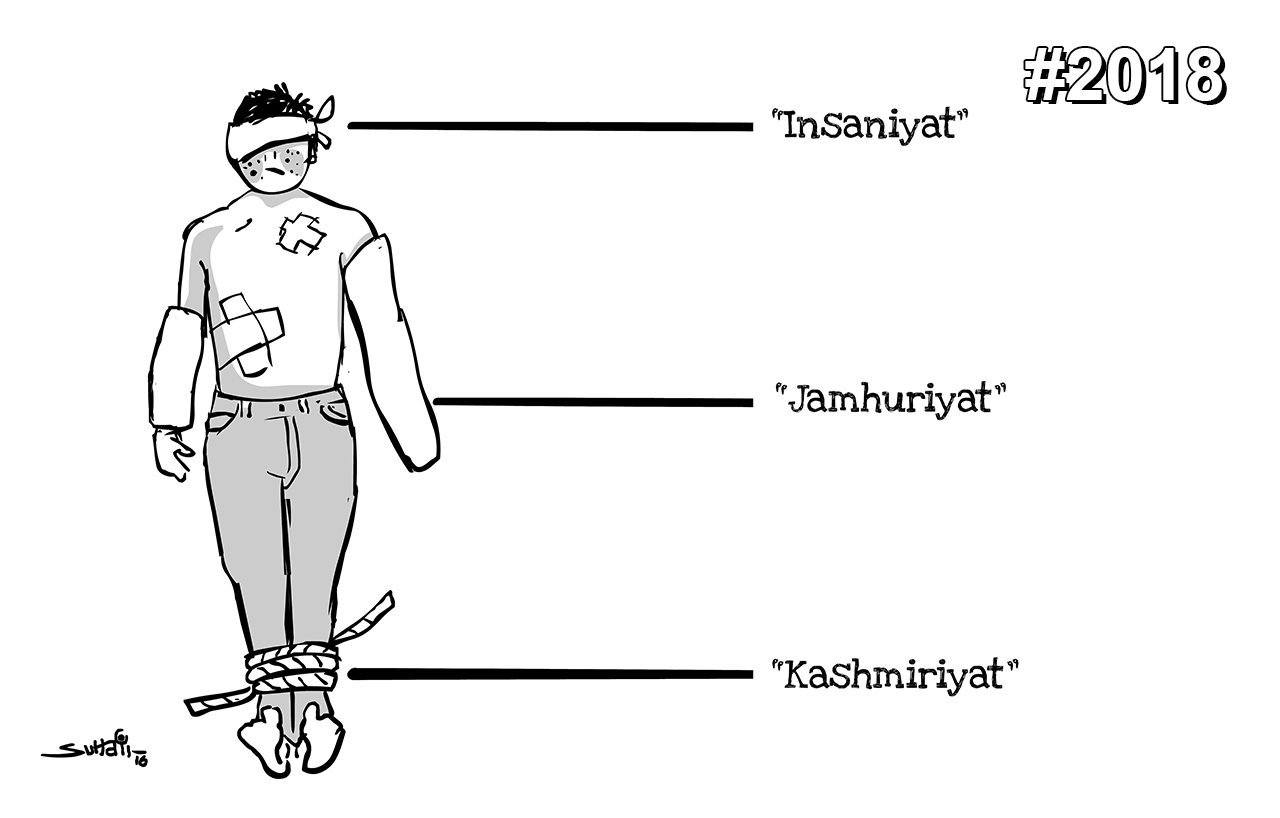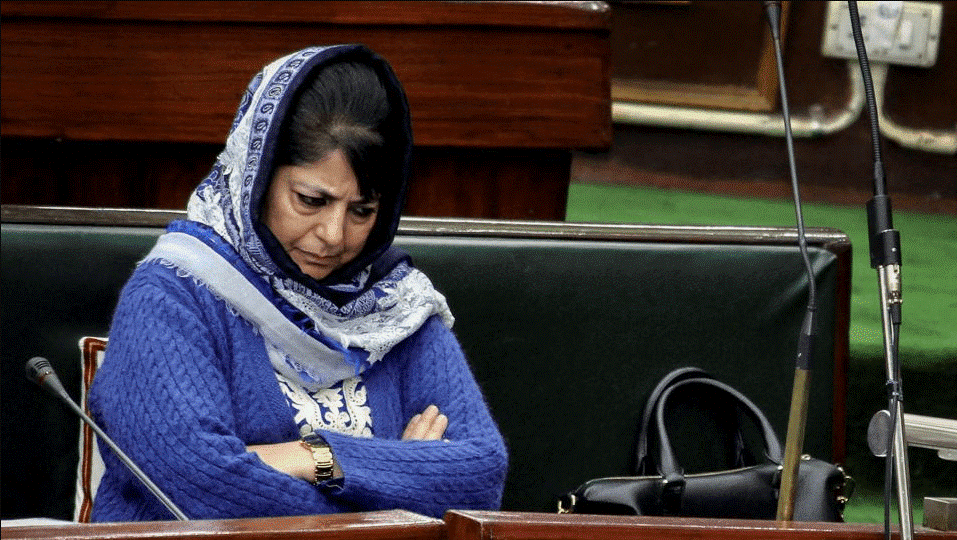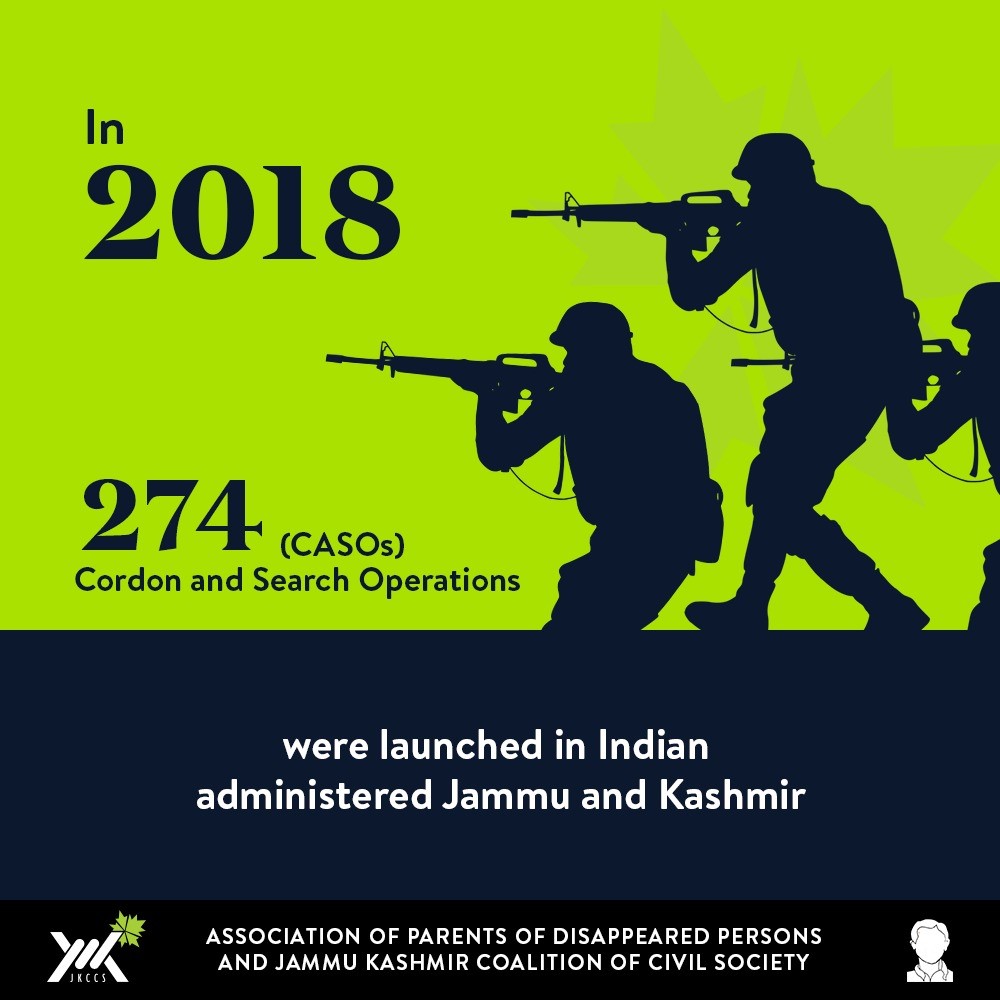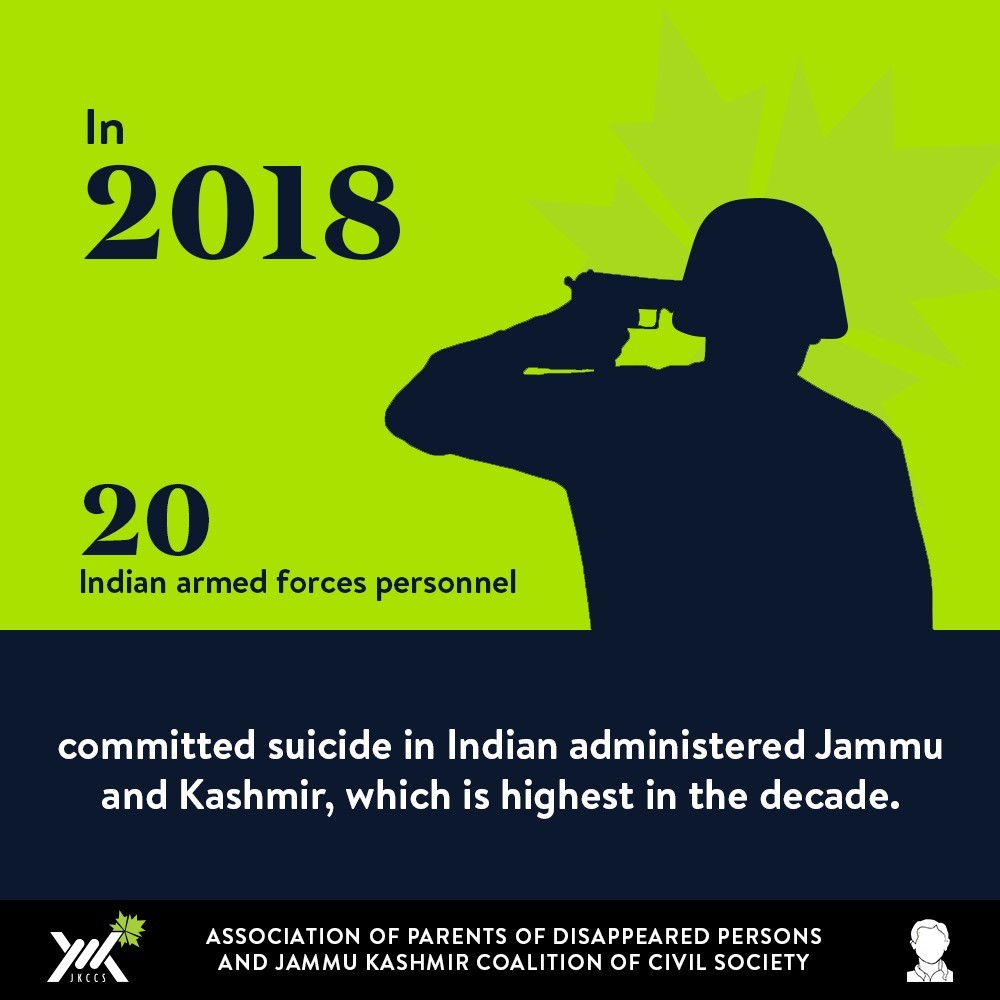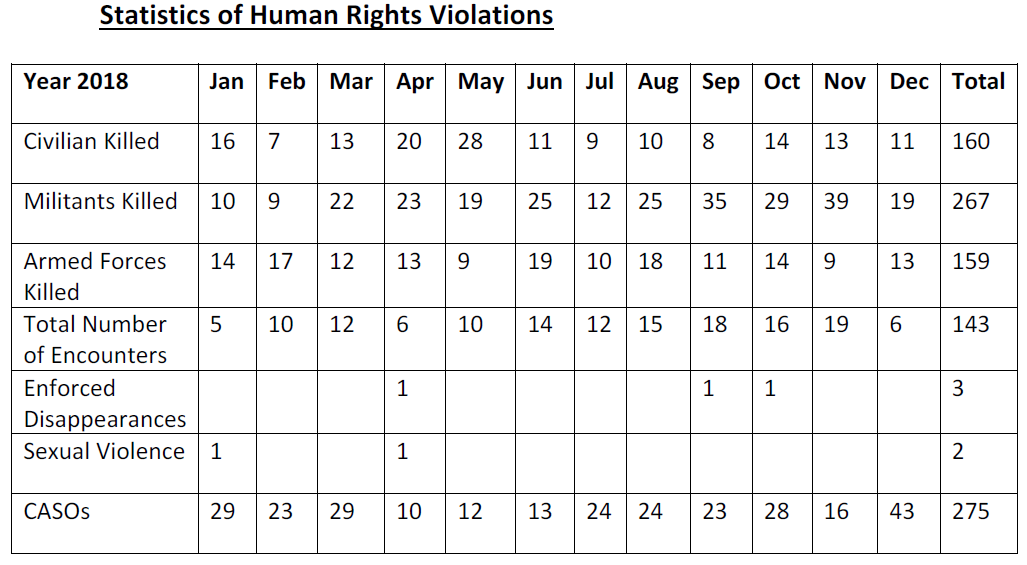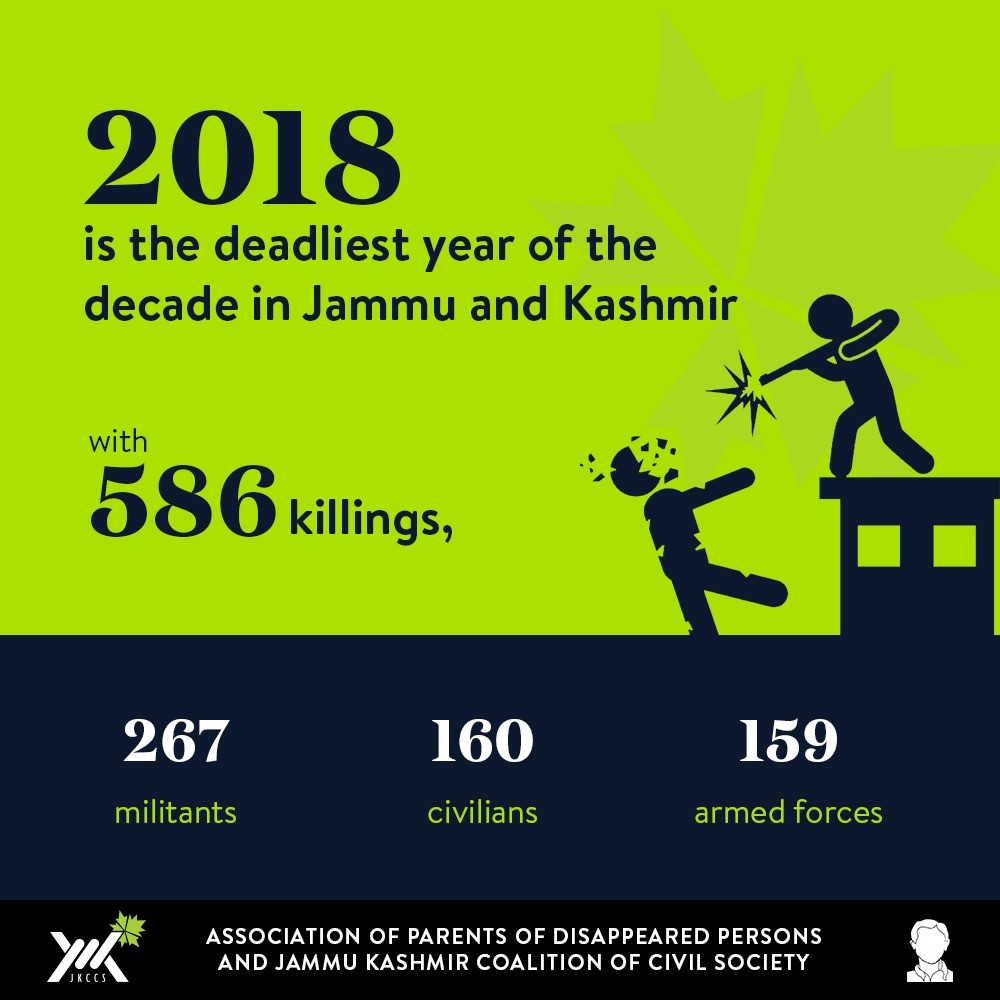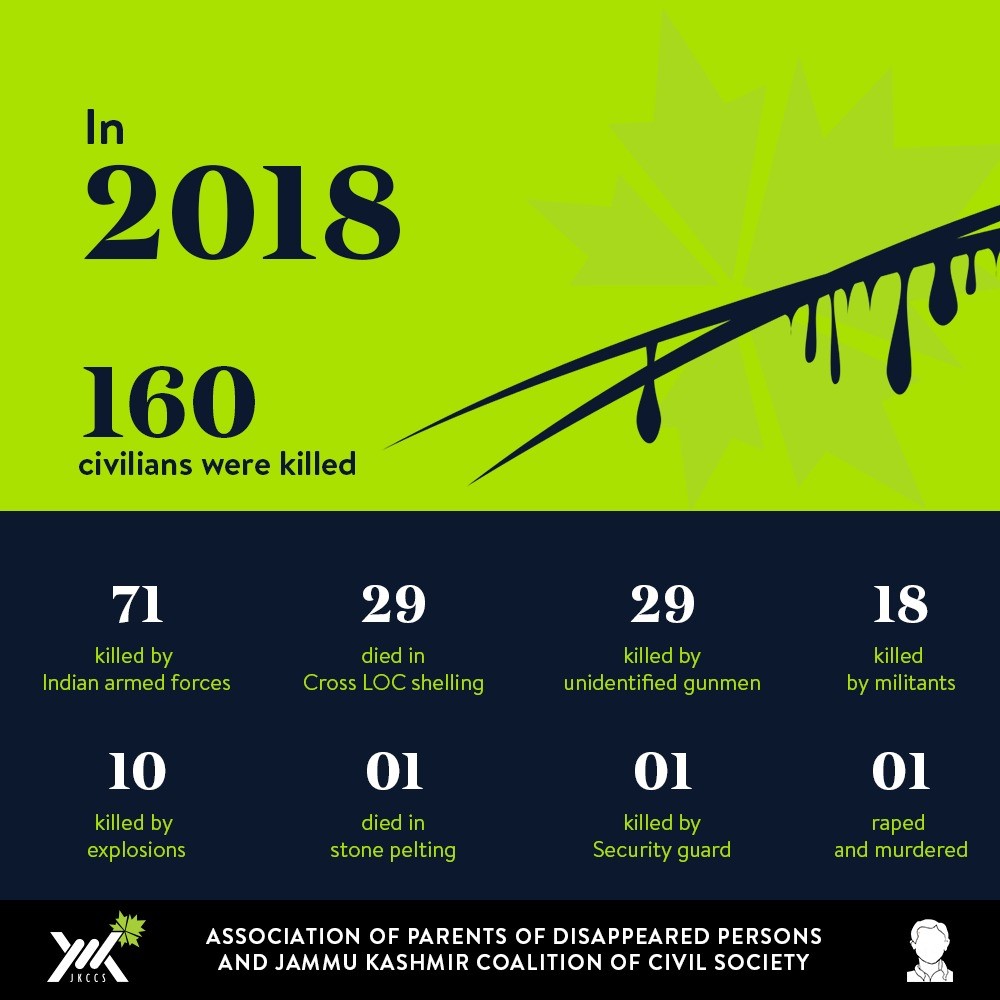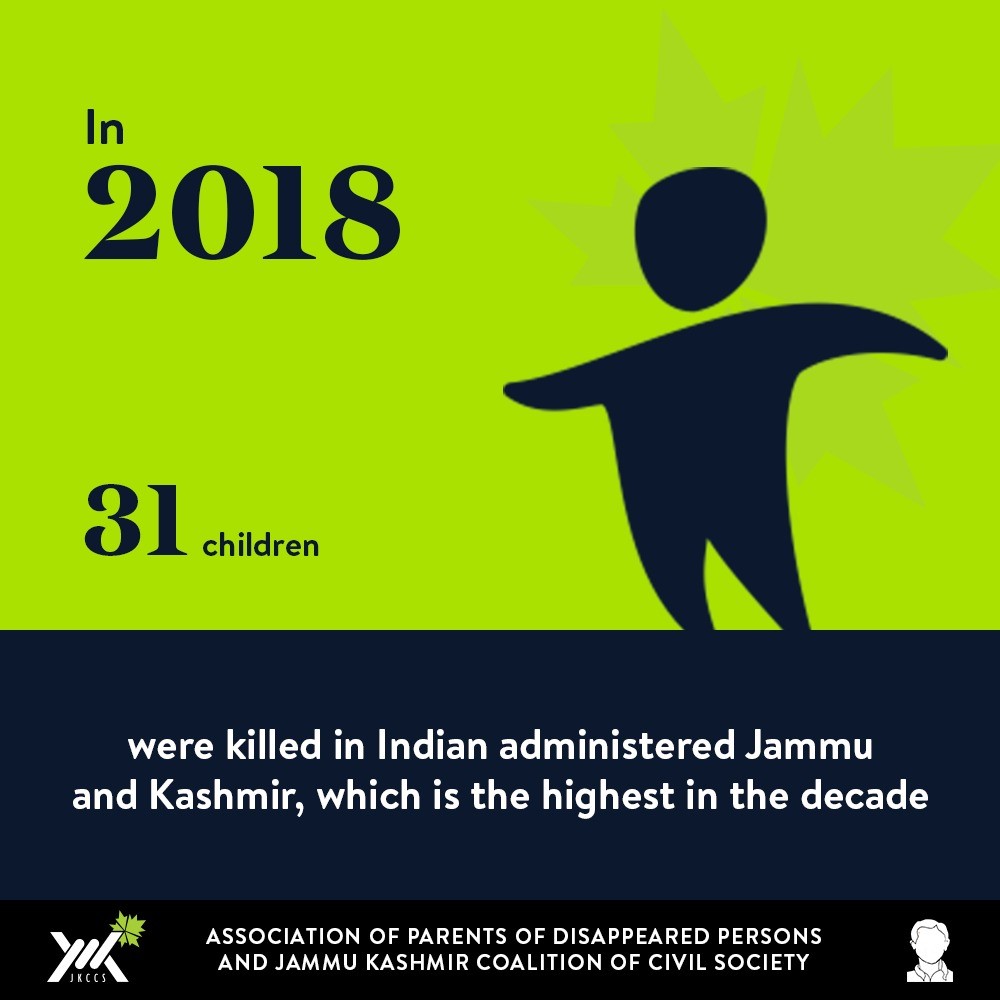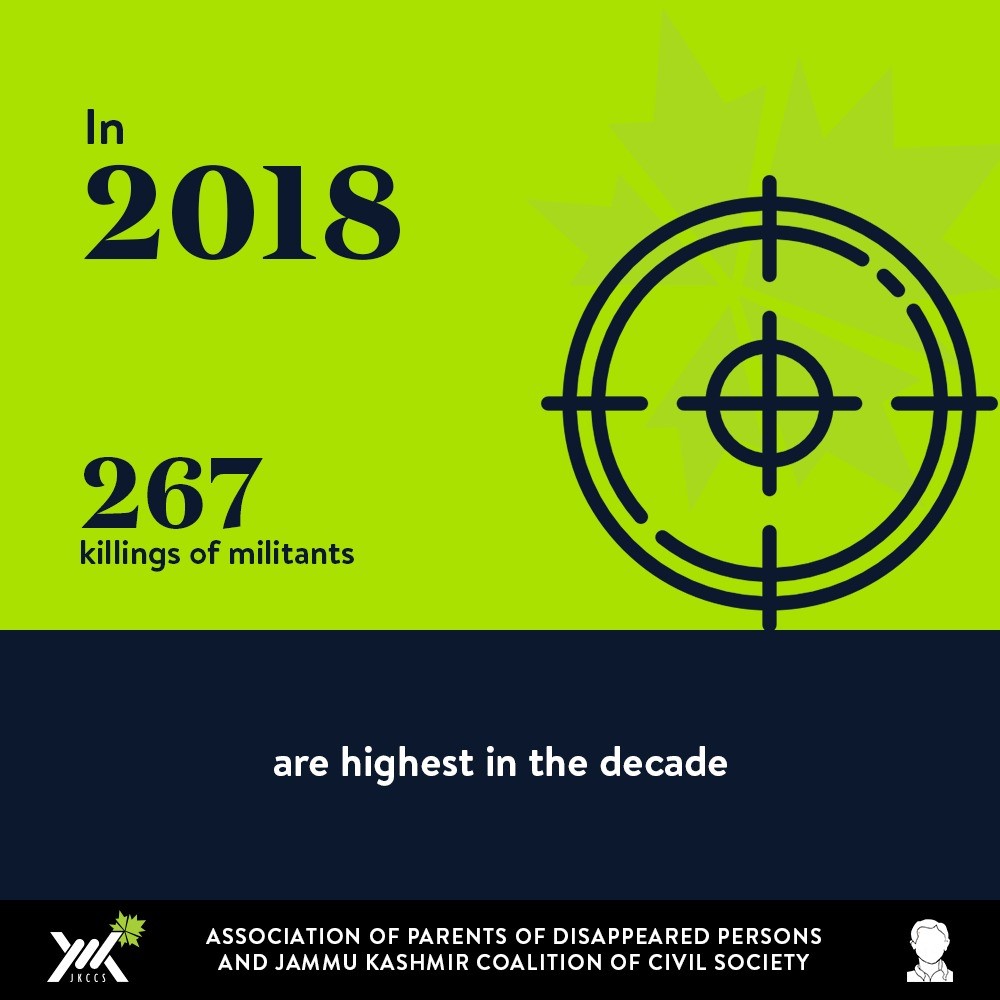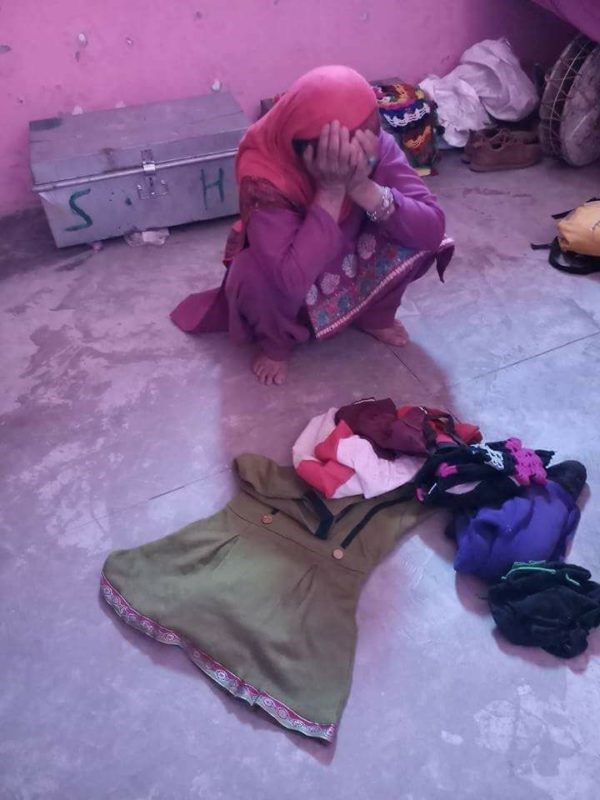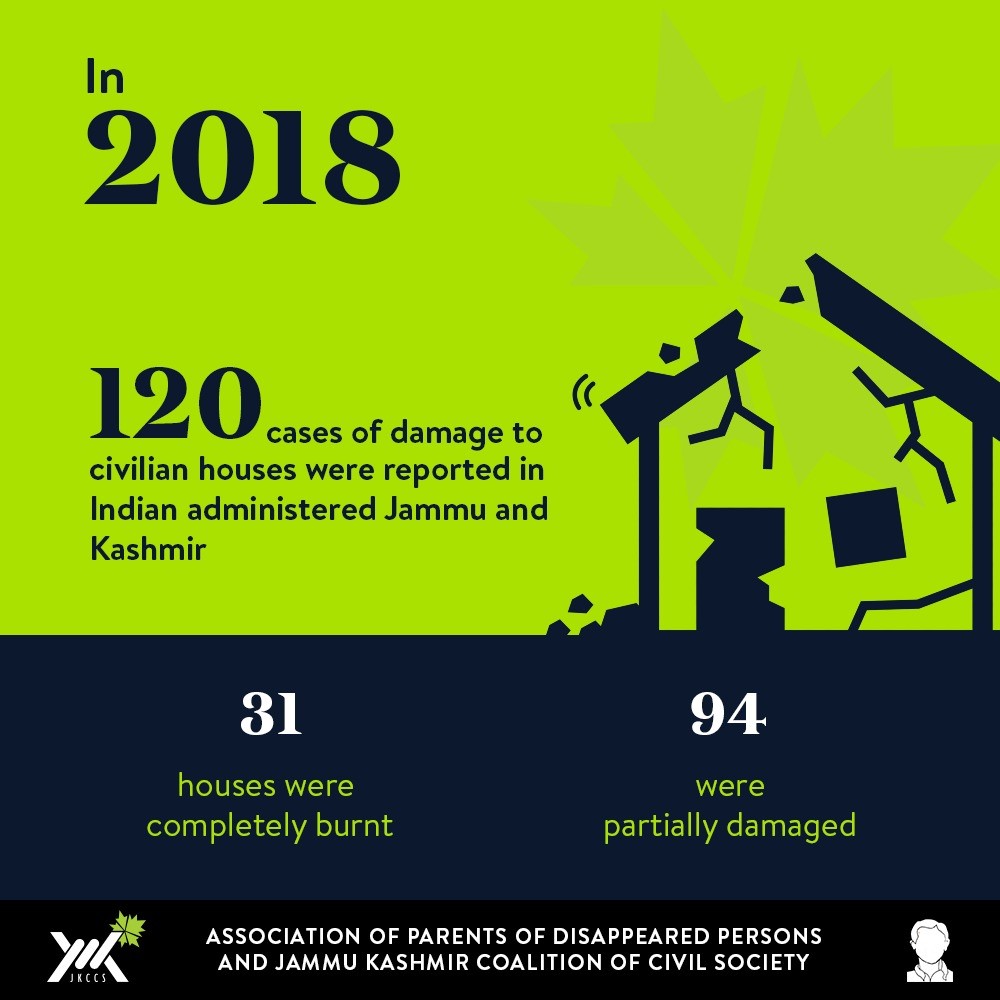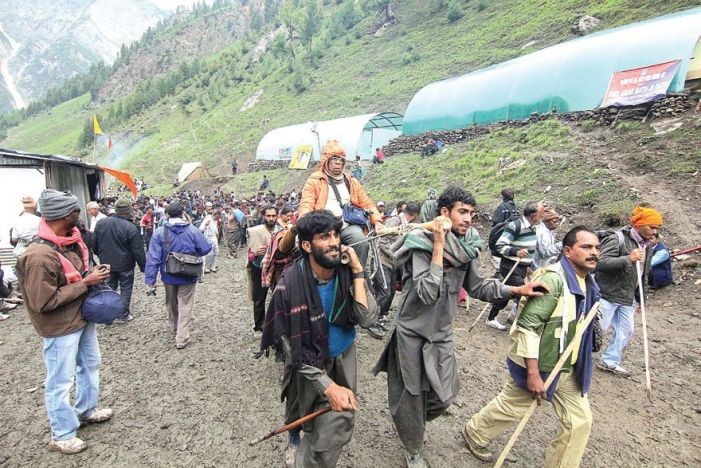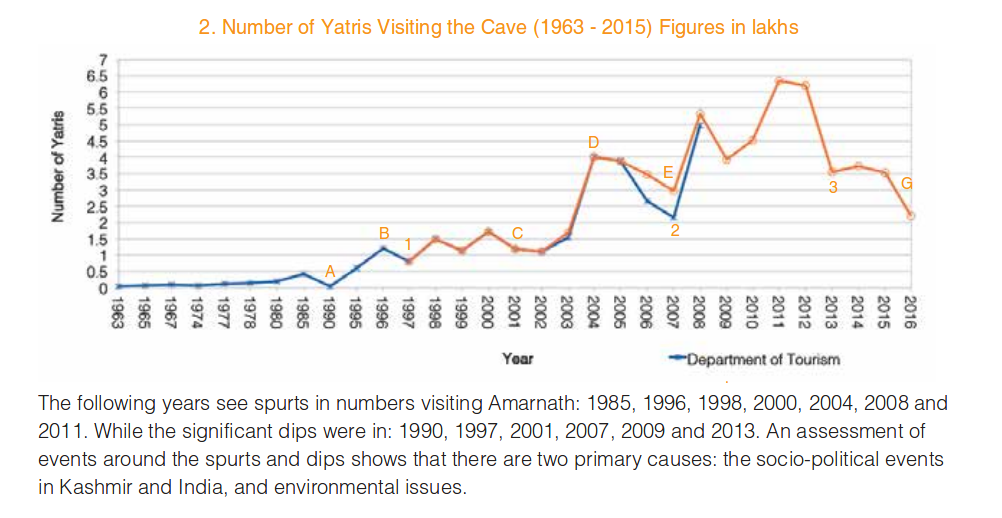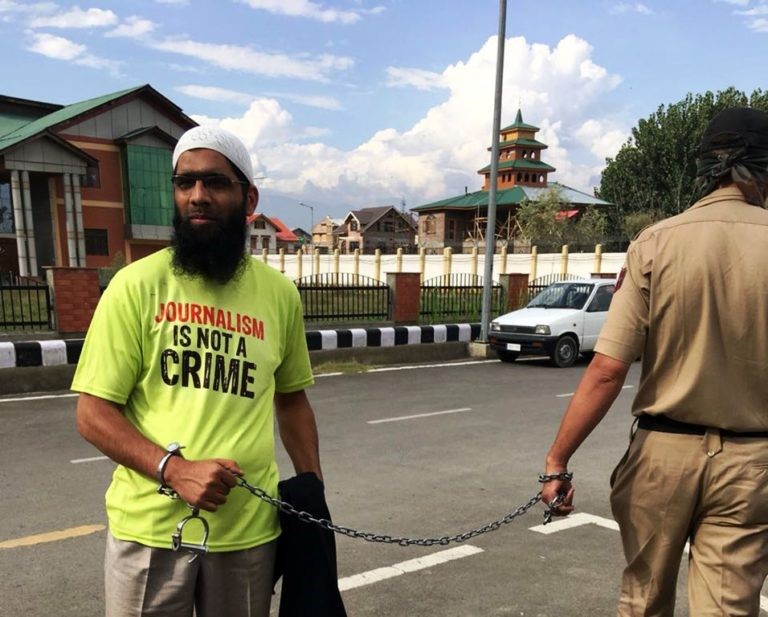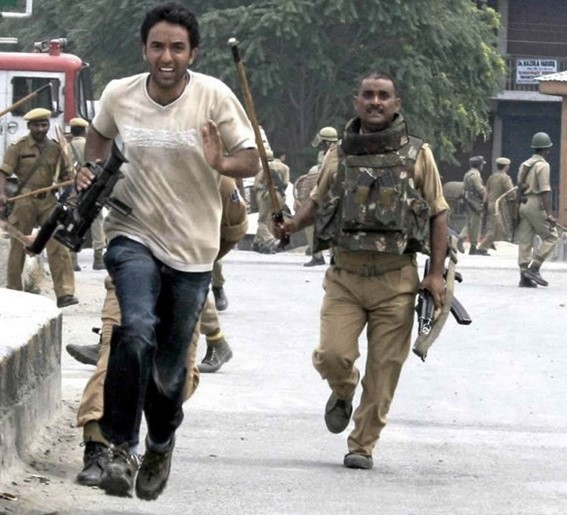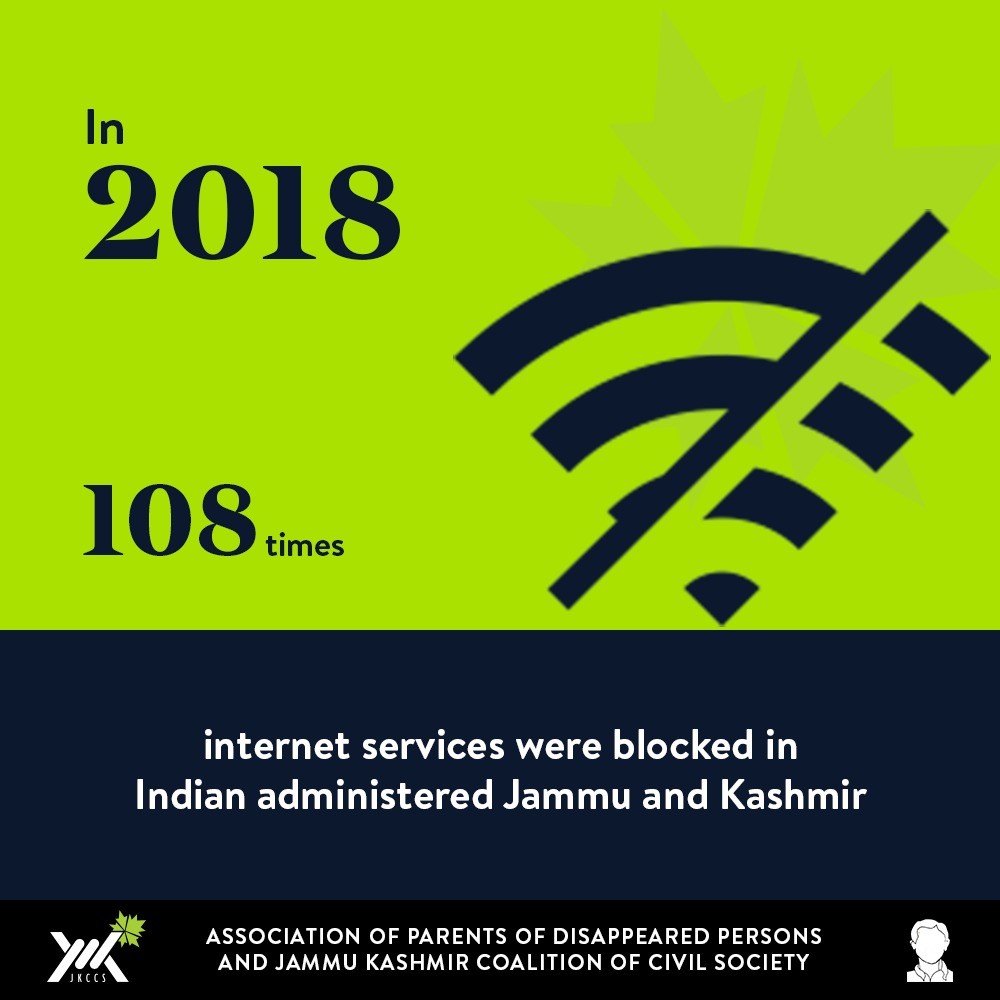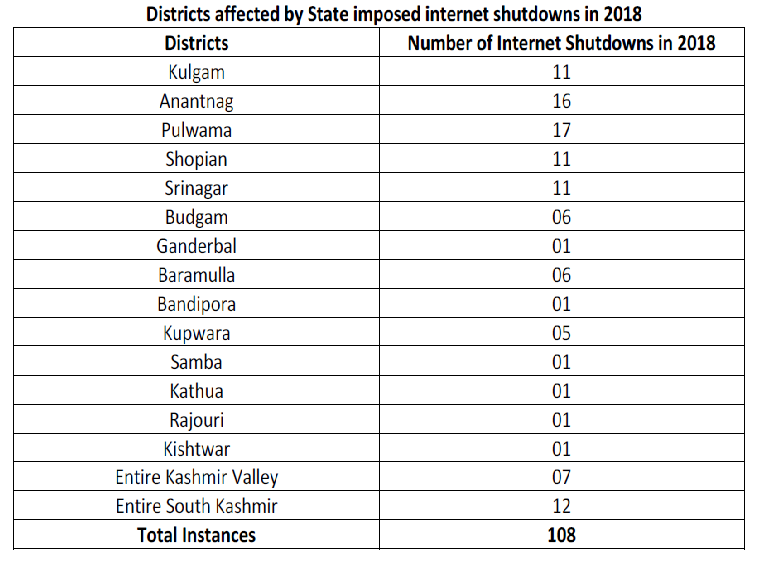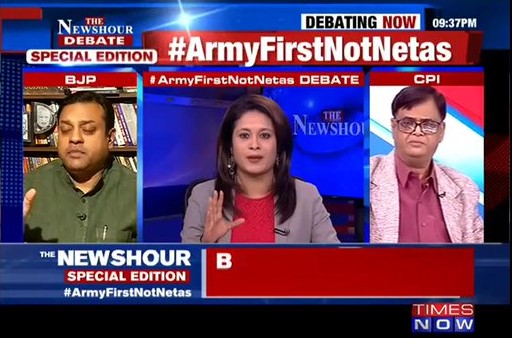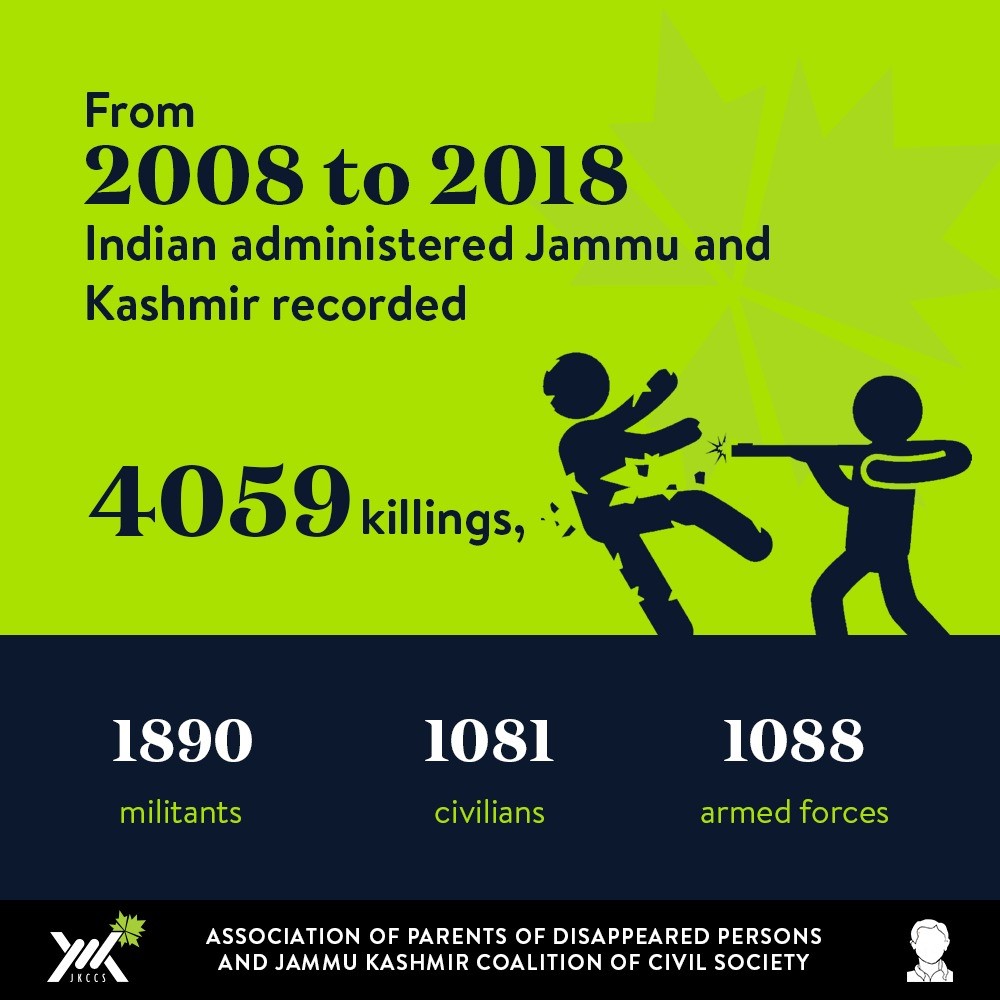2018 was arguably one of the bloodiest years in the history of Jammu and Kashmir. While the region remains one of the most militarized zones in the world, it is not only that no resolution of the historic conflict is in sight, but in fact the situation has only grown worse, the fatalities piled up, and gross human rights violations have become an everyday reality. 2018 was significant in terms of several international agencies, the UN in particular, seeming to finally wake up to the violence perpetrated on the average Kashmiri civilian by the Indian armed forces. As the country and its politics have taken a decisive militaristic turn through TV debates controlled by army men or ex-army men, as massive amounts of troops and arms get deployed in the valley, the voices of the Kashmiri civil society and journalists have been progressively scuttled through various means. Here we try and share Kashmiri civil society and others rights’ groups and media outlets’ accounts of this year’s happenings in the state, with the aim of striking a healthy and fruitful debate or discourse at least within our readers – a discourse that we hope can be taken forward in a humane sense going beyond the robotic binaries of patriotism versus anti-nationalism. If 8-year old Asifa Bano’s brutal rape and killing that shook us all in the year we just left behind, did not precipitate into any action, or pushed us to take one step towards a humane discussion that involves the lives of almost 1.5 crore people, if we still haven’t realized the gruesomeness of years long violence on a people and the toll it is taking on not just them, but also on us morally as a nation, then truly Asifa’s death has gone in vain, then truly we as citizens have betrayed our nation.
A year of increasing militarisation
On 20th December, 2018, with the end of six months of Governor’s rule, the President’s Rule has been declared in Indian Administered Kashmir. In November, J&K Governor Satyapal Malik dissolved the legislative assembly, even after Mehbooba Mufti-led PDP staked claim to form government in the state with the support of Congress and National Conference (NC), accusing the parties of horse trading. Earlier the BJP had pulled out of the ruling alliance leading to a suspended animation of the assembly, after what has been claimed as the failure of its ‘Kashmir policy’.
A striking development this year in the valley’s policy was the fall of the People’s Democratic Party (PDP). Other than its internal crisis, the party also lost popularity among the masses drastically over the past three years. If the alliance with BJP was the first betrayal, after a pre-poll promise of keeping them away from power, the list only grew over time. While PDP had promised to make the army accountable, the three-year-long tenure of the PDP-led coalition government saw the worst kinds of human rights violations. The fall of PDP last year, as the BJP pulled off its support, was celebrated in the streets of South Kashmir – an area that used to be a PDP stronghold since its formation in 1999. The area has seen hundreds of civilians killed, thousands injured and blinded, thousands booked under criminal laws and arrested, during the PDP Government.
The imposition of Governor’s rule in June was a shift in the throttle of repression. The annual 2018 Human Rights Review report published jointly by two Kashmiri civil society organisations, JKCSS and APDP, says that in the first five months an average 16 militants were killed per month; June onwards, 26 militants were killed per month. The same reports show there were an average 46 total deaths (of civilians, militant and police / armed forces) per month from June, while the first five months accounted for an average of 40 deaths per month. There was a sharp spike in the number of Cordon and Search Operations (CASOs) and Encounters in the same period. Pressures of a constant never-ending war zone is taking a toll on the lives of the Indian Army personnel as well. According to APDP-JKCCS report, 20 Indian armed forces personnel committed suicide in Indian administered J&K – the highest number in the decade.
The imposition of President’s rule indicates that New Delhi’s aggressive militaristic strategy in Kashmir shall continue.
As it is, Jammu and Kashmir has been one of the most militarized zones in the world. The present government has increased the use of armed forces even more. Not surprisingly, then, 2018 has been one of the bloodiest years in Kashmir’s history. According to the APDP-JKCCS report, 586 people were killed in 2018 alone. 160 of them were reported as civilians, 267 militants and the rest, 159 Indian army personnel. In fact, the last three years have witnessed increased killings in the valley- 145, 216 and 267 militants have been killed in the years 2016, 2017 and 2018 respectively. 31 of the 160 civilians killed are children. 16 to 20 civilians were killed by armed groups in the period from mid-July 2016 to end of March 2018, according to a UNHCR report, titled “Report on the Situation of Human Rights in Kashmir: Developments in the Indian State of Jammu and Kashmir from June 2016 to April 2018, and General Human Rights Concerns in Azad Jammu and Kashmir and Gilgit-Baltistan.”
First-ever @UNHumanRights report on #Kashmir calls for international inquiry into #humanrights violations and abuses on both sides of the Line of Control: https://t.co/8SeQ9tlhZU pic.twitter.com/P7OSNj6HJl
— UN Human Rights (@UNHumanRights) June 14, 2018
According to J&K government data, 21,400 hectares of land in Indian administered J&K is under “illegal occupation of Indian armed forces”, while 18,846 hectares are under “authorized occupation” in Kashmir including Ladakh. The militarization was increased specifically, especially in Kashmir valley, during the recent panchayat and Municipality elections, and the Amarnath Yatra, according to the APDP-JKCCS study. Currently in Kashmir valley, there are 48 Battalions of forces and 450 Camps. In addition to official forces, armed civilian militia have also been created by the Government, under the name of ‘Special Police Officers’ (similar to what has been done in Bastar in central India). “In the last two years, over 10,758 Special Police Officers (SPOs) have been engaged in J&K, in which around 5,946 SPOs were appointed in 2017,” says the human rights review report.
It further mentions that after fifteen years, in May 2017, CASO have been re-introduced in the Shopian district. In 2018, 275 Cordon and Search Operations were conducted across Indian administered Jammu and Kashmir. “CASOs often culminated into encounters that led to killings of militants as well as civilians killed extra-judicially while some civilians were used as human shields. The Indian army has been accused of harassment and ransacking of property during CASOs, including molestation of women and detention of civilians,” says the 2018 report.
As several sources have observed, Kashmiri resistance to the Indian presence has gained a kind of immediacy in the recent years. A couple of years back, the funeral of Hizbul Mujahideen commander Burhan Wani, killed by the forces, drew huge support to the streets. This year, on his second death anniversary, the government suspended internet throughout the state and increased paramilitary soldiers in sensitive zones. Funerals of slain militants have increasingly taken on a political character of their own, drawing huge numbers of ordinary people, and are often observed closely by the military and the Indian state.
In contrast to an earlier time, when the Indian state cited intense under-development and unemployment within the state that drew the “un-educated” youth to militancy, the deaths of the one-time research scholar Mannan Wani in October, and the sociology professor, Mohammad Rafi Bhat from Kashmir University in May, demand a rethinking of the essential politics of the current resistance movement. In fact, according to data provided by a police official to Newsclick, 164 youth have joined the ranks of the militants in the first 10 months (till October) of 2018, while in 2017, the number was 126. The only other period when there were more local militants was at the time of the commencement of the militant movement in the early nineties.
Repression on Kashmiris in mainland India
This hard-line approach in Kashmir has been supplemented by an atmosphere of fear and intimidation for Kashmiris residing within the Indian mainland. Since the JNU row, Kashmiri students across Indian universities have been subjected to an ever-increasing political vigilantism. Several students have faced mob attacks, have been persecuted for Facebook posts, for holding discussions on campus or just for the crime of being Kashmiri Muslims in India. Only recently ex-ABVP office bearers of the JNU unit of the RSS’s student organisation conducted a press meet claiming it was in fact ABVP students who had raised the alleged anti-India slogans, the blame of which had then been laid squarely on Kashmiri students in the varsity.
In February, two students of the Central University of Haryana were assaulted while returning after evening prayers.
In May, a five member Kashmiri family was assaulted, for feeding stray dogs, by a mob of 30-40 in East Delhi’s Siddharth Enclave. One of the victims alleged that the crowd shouted, ‘Kashmiri terrorists should be sent back.’
In August, a man was arrested by the Chattisgarh Police for ‘liking’ and ‘sharing’ a FB status message that said ‘India go back’, and booked under sedition.
At Aligarh Muslim University, two Kashmiri students were charged with sedition for allegedly holding namaaz-e-janaza on the campus following the killing of PhD student-turned-militant Mannan Bashir Wani in north Kashmir.
According to the data compiled by APDP and JKCCS, at least 22 incidents of harassment and persecution of Kashmiris living outside were reported over the year, in which 24 students were assaulted and 19 were arrested.
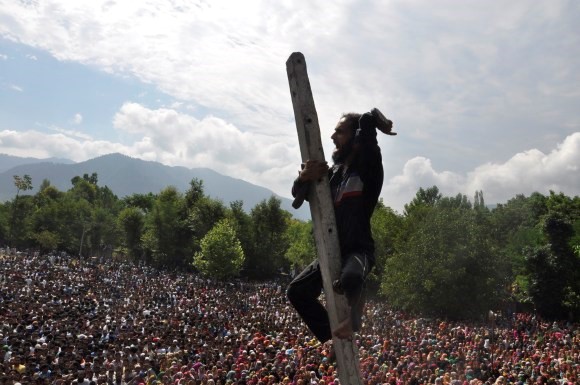
Scene from Burhan Wani’s funeral. Photo: Syed Shahriyar. Courtesy: The Wire
Sexual violence as war strategy
Sexual violence as a ‘weapon of war’ continues to be prevalent in India administered Jammu and Kashmir. Rape has been systematically used as a weapon of war to instill fear among the communities “to punish, intimidate, coerce, humiliate and degrade” the civillians. The rape and murder of Asifa, an 8 year old Bakerwal girl at Kathua in January 2018 caused world-wide outrage. Even as the charge sheet detailing the pre-meditated crime was to be submitted before the chief judicial magistrate, lawyers of the State called a strike in defence of the accused. Members of the Bar Associations of Kathua and Jammu prevented the State police from filing the charge sheet and it was handed over to the judicial magistrate at his home. Lawyers, actively helped by the right-wing Hindu Ekta Manch, carried out protests in support of special police officer Deepak Khajuria, one of the accused in the case.
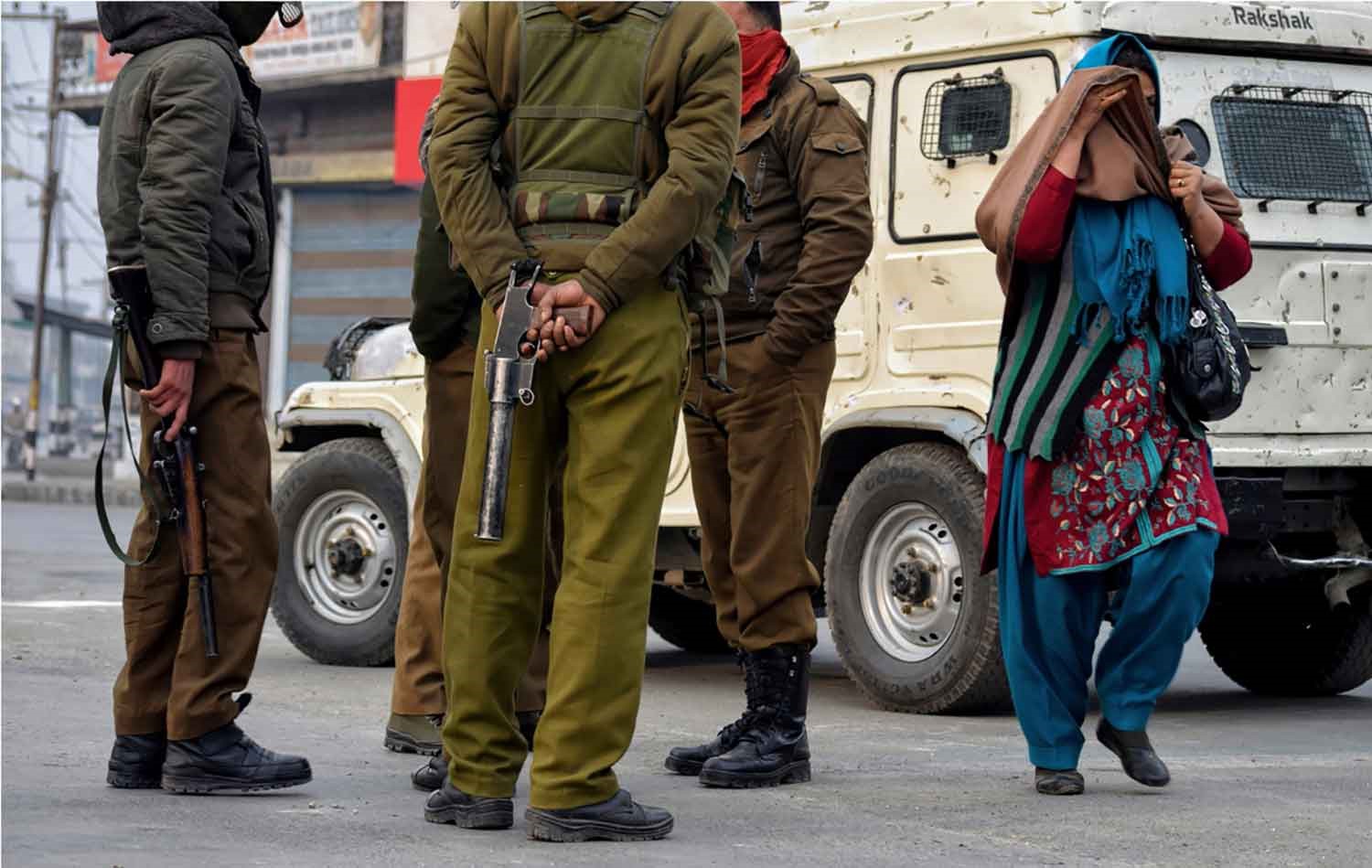
A Kashmiri woman hiding her face while passing by a group of armed forces during restrictions in old city Srinagar. Source: FreePressKashmir
On 14 April 2018, police arrested an army man for allegedly abducting a girl from Mendhar area of Poonch district, close to the border.
Same month, according to reports, a 24-year-old woman from Poonch district, had alleged wrongful confinement and rape against three CRPF personnel, prompting police to register a case and start investigations. The incident took place on March 10, when the victim was going to a relative’s home in the evening and three CRPF officials offered to help her. They took her inside the camp, one of them raped her and filmed the assault and threatened to release the video on social media if she disclosed the incident to police or anyone else. The three CRPF personnel have been suspended.
The support group for Kunan Poshpora rape victims filed a petition against sexual violence, in commemoration of Kashmiri Women’s Resistance Day. They submitted a list of 143 cases that is pending from 1989 to 2017. The Kunan Poshpora case, pending in the Supreme Court for 27 years, has hardly made any progress since 2015.
A campaign, conducted by JKCCS collaboration with One Billion Rising, received 2502 online signatures supporting the demand for ‘international inquiry into all sexual violence cases in Jammu and Kashmir, from Kunan Poshpora to Kathua.’
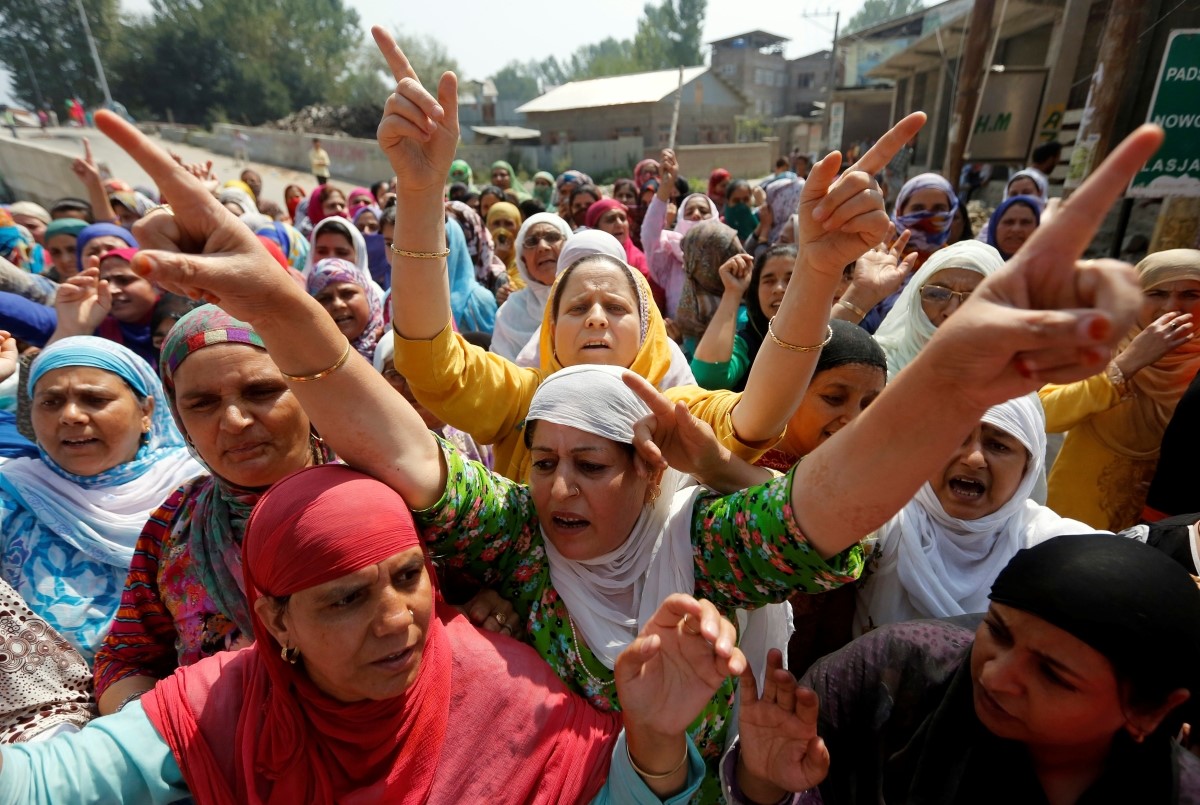
Photo: Reuters. Source: The Quint
In October, amidst allegations brought by women journalists on certain male Kashmiri journalists, a Decolonial Feminist Statement on #metoo in Kashmir came out. “However, even as we caution against the absorption of these women’s complaints into tired Islamophobic and pro-occupation narratives (example: “they seek freedom, but look at how they will treat their women”), we insist that those who support the movement for Azadi must be wary of dismissing women’s complaints and brushing them under the carpet in the name of protecting the resistance…A fair and just society for people of all genders must be an integral part of our vision for Azadi,” read the statement.
India’s Israelization
India’s administering of J&K is beginning to increasingly resemble Israel’s way of administering Palestinians in Gaza, West Bank and Jerusalem.
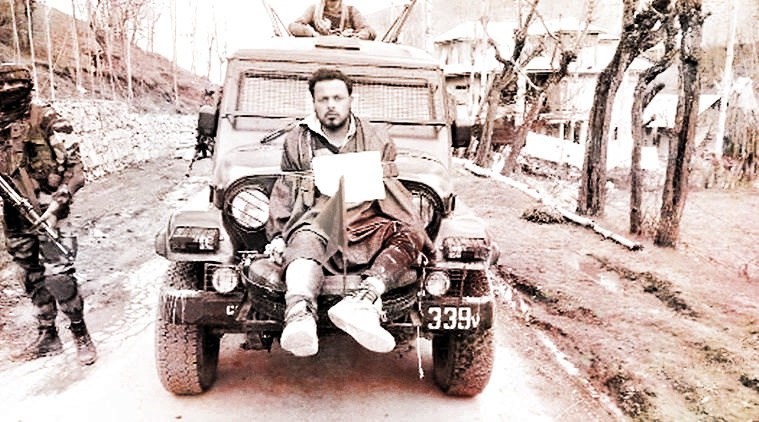
In a video that emerged on 14 April 2017, a Kashmiri man, Farooq Ahmad Dar, was seen strapped to the front of a moving Indian Army jeep, while a soldier can be heard shouting, “This will be the fate of those who throw stones.” Photo Courtesy: The Wire
Human shields: India’s increasingly Israeli style operation made rounds in the media in 2017 when Major Leetul Gogoi used a Kashmiri civilian tied to his jeep as a human shield to protect himself from stone pelting. Israel has been historically held responsible by various international human rights organisations for its regular use of human shields against the Palestinian resistance in Gaza and West Bank. Faced with outrage, the Israeli High Court banned the use of human shields in 2005. Their Chief Justice, Aharon Barak said, “You cannot exploit the civilian population for the army’s military needs, and you cannot force them to collaborate. Based on this principle, we rule it illegal to use civilians as human shields.” However, Major Gogoi was awarded a commendation card by Army Chief General Bipin Rawat. Rawat previously defended Major Gogoi, saying this is an innovative military strategy to keep the morale of his men high.
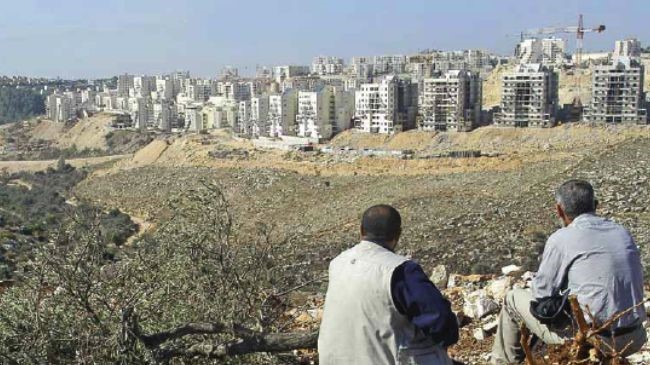
Typical Israeli settlement in the making, in East Jerusalem. Source: The Levant News
Article 35-A: Based on a 2014 petition filed by an NGO “We the Citizens” reportedly backed by the RSS, the present central government sought for a debate on Article 35-A of the Constitution in the Supreme Court in August last year, creating a furore in Jammu and Kashmir. The next hearing on the petition has been postponed till 22 January. Article 35-A declares a “special status” for the state of J&K in the Indian union, guaranteeing that only Kashmiris have rights to inherit and own property here. “If Article 35A is removed, settlements will emerge in Kashmir and we will turn into a minority. The only thing that stops India from implementing a resolution is the fact that ours is a Muslim-majority region. They want to change that,”, said Hameeda Nayeem, Professor of English at the University of Kashmir.
Settler Communities: For years now, separate colonies for the Kashmiri Pandits have been proposed. Demands are also being now raised for colonies for retired colonels. While the Kashmiri Muslims have not objected to the return of Kashmiri Pandits to their land, they have opposed the idea of separate settlements, fearing these separate colonies will be used to create even further polarization in an already troubled region. Kashmiri Muslims have welcomed the return of Kashmiri Pandits to their homes, but not in separate colonies.
Politics of pilgrimage: Amidst this repression and bloodshed the Amarnath Yatra last year attracted 2 lakh pilgrims. Hindu right wing forces have long used the Amarnath Yatra as spirituo-patriotic pilgrimage in the region. The SASB (Shri Amarnath Shrine Board) Act in 2001 was passed to ensure that Kashmiris themselves remain outside the decision making process in these yatras. There was no discussion, no media coverage when the bill was passed and then the Supreme Court judgment was made. The judgment directs that “the State should leave all matters connected with the Yatra, provision of the infrastructure, performance of the Puja and other welfare matters to the Board and concentrate itself for the security arrangements during the period of yatra and of course to see that public order is not disturbed.”
The JKCCS and Equations’ report, “Amarnath Yatra- A Militarized Pilgrimage”, terms this as a strategy to create a “State within the State”. Swathi Sheshadri, in a Newsclick interview, explains how the formation of the SASB by the Indian state has led to a greater access of the Hindu political right wing into the various structures of Yatra, and how the Indian government along with the Hindu nationalist forces, are using this access to erase the specific cultures and histories of Kashmir. Since the Amarnath yatra began in 1995, the number of days of the yatra has increased over the years. From the initial 15 days, the Yatra now takes place for almost 60 days. Various right-wing Hindu groups are now trying to transform the cave into an alternate holy space, by emphasizing “the mythological belief that Shiva narrated the story of immortality to Parvati here. Thus suggesting that the Yatra may be undertaken all through the year” (pp. 97, Amarnath Yatra – A Militarized Pilgrimage). The report also suggests, these yatras are conducted in areas where the self determination movements are strong. The centrally sponsored yatra has long been used to create a concocted history of Kashmir.
In July 2017, eight people were killed in an armed attack on a bus carrying Amarnath pilgrims. The attack took place in Batengoo area of south Kashmir’s Anantnag district. Laskar-e-Toiba was blamed for the attack, and a chargesheet had been filed against 11 persons. Different sections of the society in Kashmir had condemned the attack. The Federation Chamber of Industries (FCIK) had called the incident a ‘dastardly action’. Jama’at e Islami had said that it was “a cowardly act which only a frustrated lot can commit,” the spokesperson added.
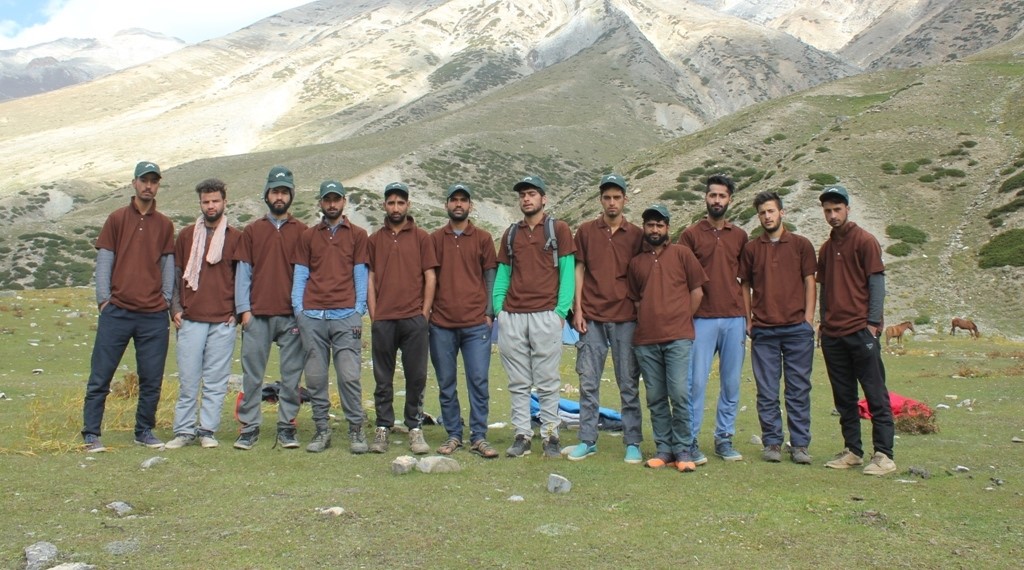
Notwithstanding the National Green Tribunal directions, Governor N N Vohra decided on a 60-day-long, instead of the earlier 45-day-long, Amarnath Yatra in June 28, 2018. These are 25 Kashmiri volunteers – the Majid Squad – a group that voluntarily cleans filth on Amarnath Yatra routes. Source: FreePressKashmir
Indo-Israel war ties: The ties between India and Israel increased over the years. India became the highest purchaser of Israeli arms in 2017, with a whopping $9.2 billion dollar deal. The post-Cold War emergent diplomatic relations between the two nations was further cemented by the visit of Prime Minister of Israel, Benjamin Netanyahu, in January 2018. His visit reportedly revived a canceled $500 million deal between Israeli arms manufacturer Rafael and India for Spike anti-tank missiles. The Rafael deal (different from Rafale) ended in affirmative after his visit, along with signing of nine other agreements of strategic cooperation. These same arms are used in anti-insurgency operations in Kashmir, North East and Bastar.
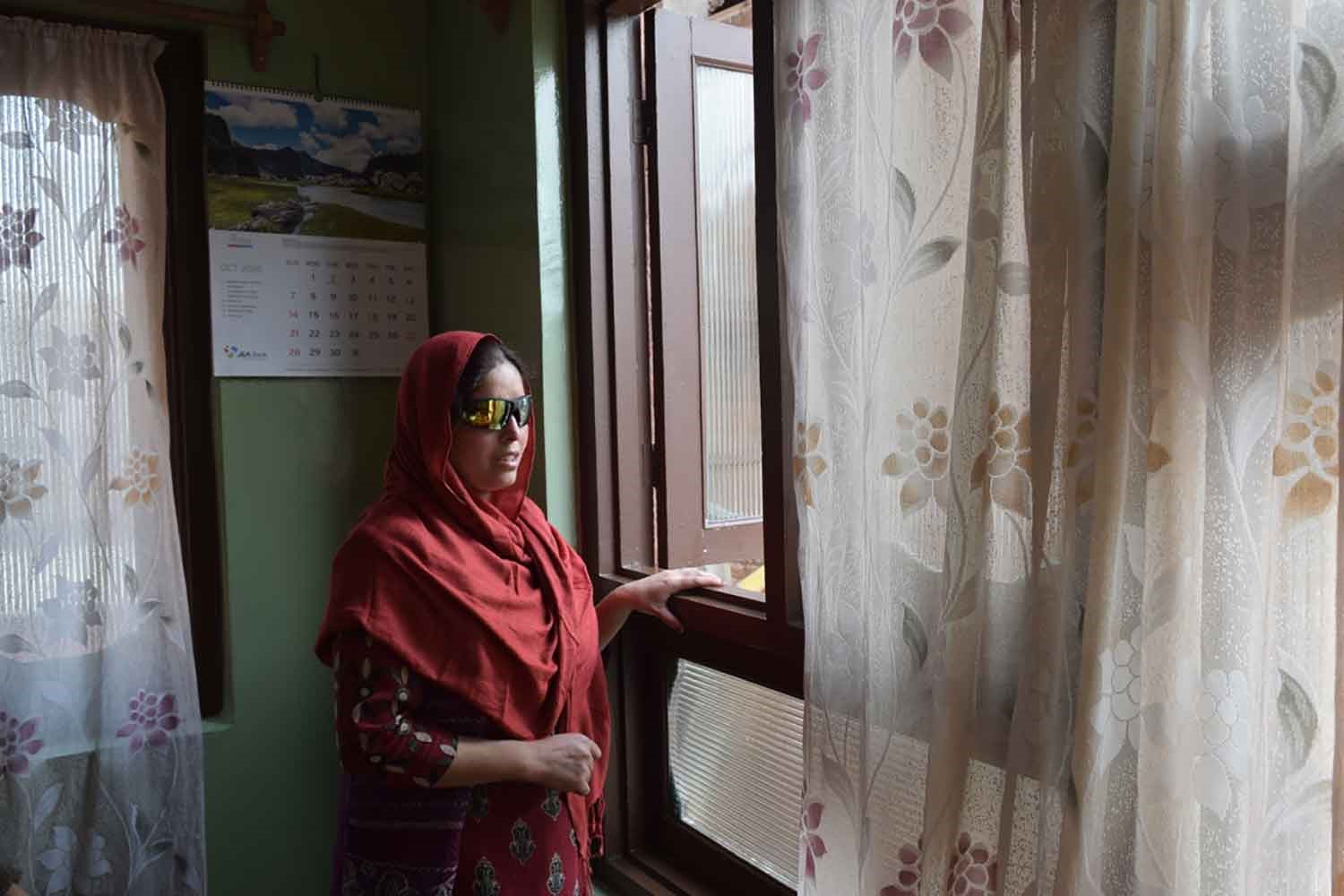
Nusrat Jan, 32, stands near the window where she lost her eyesight when a pellet fired by Indian armed forces pierced her right eye following the intense clashes near the gunfight site at Fateh Kadal area of old Srinagar. Source: FreePressKashmir
Drawing striking similarity with how Israel deals with Palestinian protestors in Gaza and West Bank, Indian Government has been using more and more of pellet firings on Kashmiri protesters in recent years. According to human rights organizations, the 12-gauge pellet-shotgun use cartridges that contain 500 to 600 pellets that resemble ball bearings. The ammunition is made of lead alloy that is fired at a high velocity thereby dispersing the metal pellets over a large area. Experts claim that there is no way of adequately controlling the trajectory of these shotguns beyond a limited range, which makes them inherently inaccurate and indiscriminate. The CRPF claims the pellet-firing shotgun is the “least lethal” option they have for crowd-control. However, pellet shotgun use by law enforcement agencies resulted in multiple deaths and serious injuries of hundreds civilians between 2016 and 2018. In January 2018, Chief Minister Mehbooba Mufti herself stated before the state assembly that 6,221 people had been injured by pellet guns in Kashmir between 8 July 2016 and 27 February 2017; among the victims, 728 had eye injuries. Civil society organizations claim that the number of people partially or completely blinded due to pellet injuries is higher. A right to information query found that 16 personnel from the Jammu and Kashmir Armed Police were also injured by pellet-firing shotguns. “On 1 April 2018, around 40 people were reportedly injured, including 35 hit in the eyes, by pellet shotguns used against people protesting against the killing of civilians in Shopian and Anantnag districts,” according to the OHCHR data.
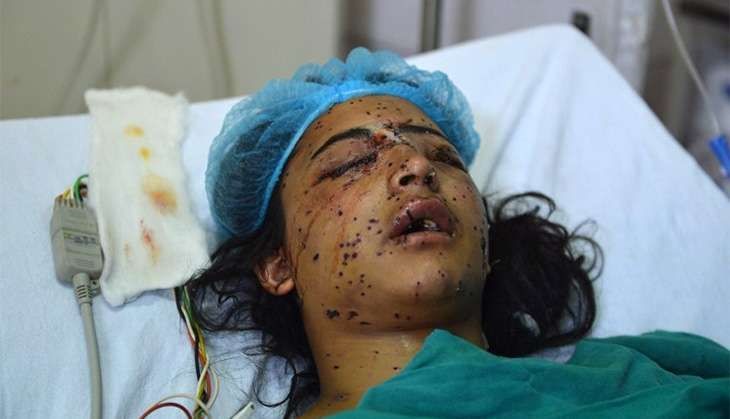
14-year-old Insha Malik, of Shopian, was brought to hospital with 100 pellets lodged mostly in her face, in 2016. She somehow managed to survive, but lost vision permanently in both her eyes. Insha wanted to grow up to become a doctor. Source: India Times
Attack on Media and Journalism
“The space for journalists to carry out their work without fear of being targeted has been completely choked,” said the APDP Annual report. 2018 saw attacks against journalists taking a brutal shape in the targeted assassination of prominent journalist Shujaat Bukhari by unknown gunmen on 14 June 2018.
In March, after 6 months long incarceration Kashmiri freelance photojournalist, Kamran Yousuf was finally released on bail from Tihar Jail, New Delhi under unsubstantiated charges of ‘stone-throwing’ brought by the National Investigation Agency (NIA) in September 2016.
On July 23, Jammu Kashmir Police physically assaulted local daily Rising Kashmir’s cameraman Farooq Shah near Barzulla Bridge in Srinagar, while he was on his professional duties. In September journalist Asif Sultan was arrested after his reporting on Burhan Wani.
In September 2017, the Free Press Kashmir published a list of journalists killed in Kashmir in a report titled “#JournalismIsNotACrime: List of Journalists killed and attacked in Kashmir proves otherwise”.
According to reports, the Centre issued an “advisory”, in July, to foreign correspondents working in India, reminding them that they need prior permission before traveling to certain “protected” areas, including Jammu and Kashmir. Based on the same advisory, Washington Post’s India bureau chief Annie Gowen was denied permission to report on Kashmir.
As the two-pronged attack on journalism in Kashmir continued – with corporate media on the one hand suppressing and distorting news, and the state on the other hand mounting attacks on and intimidating professional journalists – ordinary Kashmiris took to social media exposing Indian Government’s human rights violations. As the circulated videos of atrocities garnered force, the internet shutdowns increased over the years. There were 108 instances of internet blockade in Indian administered Jammu and Kashmir. The South Kashmir districts of Kulgam, Anantnag, Pulwama and Shopian recorded the highest instances of internet shutdowns with 67 such instances.
The Indian state’s approach has been widely critiqued, including by international agencies such as the United Nations, for reinforcing occupation of the ordinary Kashmiri’s life in multiple ways, everyday. As the use of brutal armed force continues, protected from legality by draconian laws like the AFSPA and PSA, the “right to self determination of the people of Kashmir as protected by international law” continues to get thwarted. Indian mainstream media has, mostly, downplayed the everyday realities of the Kashmiri civilian.
As an example, while a mainstream Indian newspaper used headlines such as “Separatist-backed strike hits normal life in Kashmir…” to brush off the state-wide shutdown that was observed on December 10th, several Kashmiri newspapers took the opportunity to actually talk about human rights violations in the state. For example, this FreePressKashmir photo essay on women in Kashmir and their situation. “While Indian-Administered Kashmir has experienced waves of protests in the past in the late 1980s to early 1990s, 2008 and 2010 this current round of protests appears to involve more people than the past, and the profile of protesters has also shifted to include more young, middle class Kashmiris, including females who do not appear to have been participating in the past,” said the 2018 UNHCR report. The Government of India, and mainstream Indian media, rejected the report calling it “fallacious, tendentious and motivated” and a violation of the country’s sovereignty and territorial integrity.
Feature Image: Greater Kashmir. Source: The Scroll.

